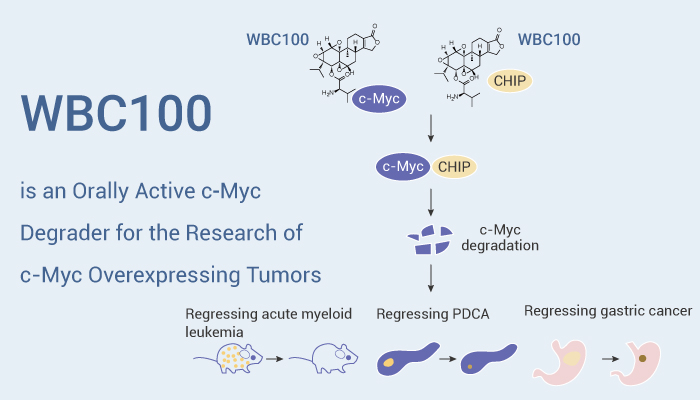c-Myc is a member of the basic helix-loop-helix leucine zipper (bHLHZip) protein family. The target genes of the c-MYC protein participate in different cellular functions, including cell cycle, survival, protein synthesis, cell adhesion, and micro-RNA expression. c-Myc is also one of the four factors used in reprogramming somatic cells to induce pluripotent stem (iPS) cells and is implicated in maintaining cancer stem-like cells (CSCs). Most biological functions of c-Myc require heterodimerization with its activation partner Max. c-Myc is also part of a dynamic network whose members interact selectively with one another and with various transcriptional coregulators and histone-modifying enzymes. Deregulated expression of c-MYC caused by gene amplification, retroviral insertion, or chromosomal translocation is associated with tumorigenesis. c-Myc has been identified as a highly promising target for cancer therapy.

WBC100 is an orally active c‐Myc degrader for the research of c-Myc overexpressing tumors.
WBC100 (14-D-Valine-TPL) is a potent, selective, and orally active c‐Myc molecule glue degrader. It is a c‐Myc degrader and targets ubiquitin E3 ligase CHIP mediated 26S proteasome pathway. Moreover, it is used for c‐Myc overexpressing tumor research. Firstly, WBC100 selectively kills cancer cells Mia-paca2, H9, and MOLM-13 cells overexpressing c-Myc and normal human cell lines L02, MRC-5, and WI38 cells low expressing c-Myc. Secondly, WBC100 (0-320 nM; 24 hours) reduces c-Myc protein levels in MOLM-13 cells and Mia-paca2 cells in a dose-dependent manner, but has no significant effect on XPB, Rpb1, and STAT3. Furthermore, MG132 can rescue WBC100-induced c-Myc protein.
WBC100 (p.o.; 0.1-0.4 mg/kg; Twice daily; 21 days) exhibits dose-dependent antitumor activity in vivo. High or medium doses (0.4/0.2 mg/kg) of WBC100 eradicated MOLM‐13‐luciferase cells in vivo, and all mice survived disease-free at day 35. In addition, at a low dose (0.1 mg/kg), WBC100 can significantly inhibit tumor growth and prolong survival in leukemia mice. WBC100 (p.o.; 0.4-0.8 mg/kg; once daily; 14 days) eliminated refractory MOLM‐13‐luciferase cells in vivo, but (+)‐JQ1 (50 mg/kg, intraperitoneal (i.p.), once daily for 14 days) was ineffective in inhibiting tumor growth. WBC100 exhibits stronger antitumor activity than the c‐Myc transcriptional inhibitor (+)‐JQ1.
In conclusion, WBC100 (14-D-Valine-TPL) is a potent, selective, and orally active c-Myc molecular glue degrader for the study of c-Myc overexpressing tumors.
References:
[1] Ying Xu, et al. Adv Sci (Weinh). 2022 Mar;9(8):e2104344.
[2] Shelia D. Thomas, et al. Clin Cancer Res. 2012 Oct 15;18(20):5546-53.